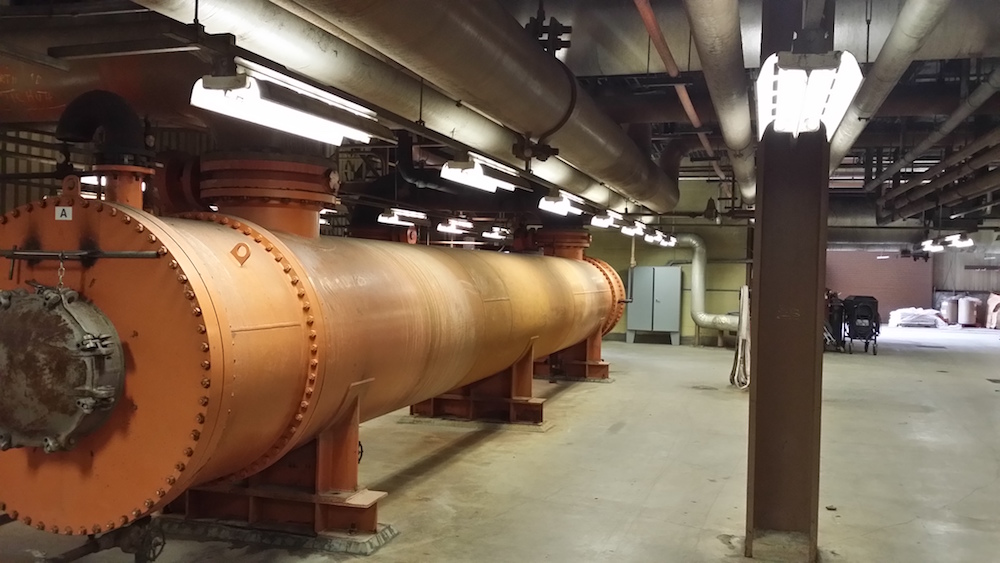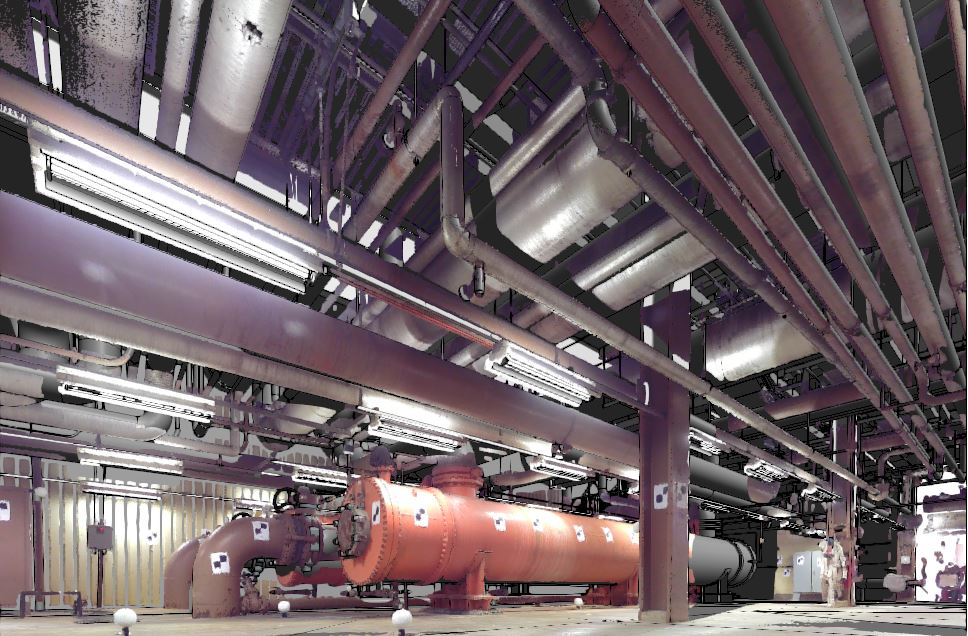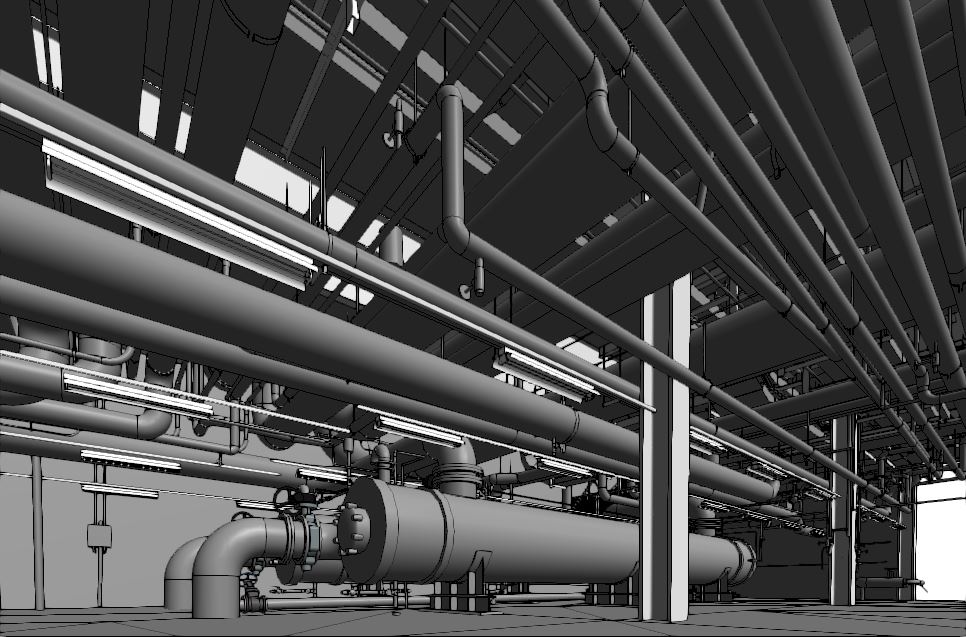When the power division of Black & Veatch needed to perform field measurement and modeling of the complex Iatan 1 Power Plant, located near Platte City, Missouri, they engaged Structural Modeling & Analysis (SMA), a Kansas City-based firm specializing in structural engineering design and analysis as well as laser scanning and modeling. SMA was brought in at the urging of Kansas City Power & Light Company (KCP&L) in order to save time and money while navigating the unique challenges created by a pipe-dense plant. The job entailed laser scanning the site to collect all the data, registering, making a model showing all the piping in Autodesk® Revit® and exporting it out in AutoCAD® to deliver results, enabling the safe and successful installation of a new heat exchanger.
Challenges
Black & Veatch, a large engineering, procurement and construction (EPC) company, understood the complexities of the 651-megawatt (MW) Iatan 1 Power Plant site, including the quantity and density of the piping as well as how little room for error existed due to all the piping connections required between the existing heat exchangers and the new one they wanted to install. Black & Veatch did not, however, have much experience in laser scanning, therefore, SMA Engineering was contracted to conduct the condition survey of the plant.
Due to the tremendously complex, pipe-dense space, the engineer’s plan initially budgeted six to eight weeks for field measurement and approximately 10 additional weeks for modeling the information from the field. In addition to the inordinate amount of time they were looking at, another concern was accuracy: trying to measure a space that was approximately 100 feet long by 50 feet wide, with two floor levels, three levels of cable trays and 2,000 pipes is a daunting task if using traditional methods such as tape measures and standard field measurement practice.
Safety and workflow at the power plant were among the other major challenges with this project. According to J Brown, P.E., S.E., Principal Engineer at SMA, “Given the multiple floors and dense piping, the safety of those performing the work would be of utmost concern. Utilizing traditional measuring methods, there would be little chance to safely access all the spaces required.” Another concern was how not to interrupt the workflow of the location, something that is critical at an active power plant.
Solutions
Time
With their expertise in utilizing laser scanner technology and modeling, the SMA team went into the space and performed a total of 93 scans using the FARO Focus3D X 330 Laser Scanner, in just 12 hours—a day and a half of work.
Prior to leaving the site, SMA began registering the scans and checking to confirm they had sufficient data to accurately model the cable tray, piping and equipment. In addition, they performed their confirmation process to back-check the scan data to the real world.
Brown explains the process further: “Once back in the office, the processing and registration was completed using SCENE, FARO’s 3D documentation software. At that point, the scan data was run through Autodesk® ReCap 360™ to create the files for use with Autodesk® Revit®. Then, we used Trimble EdgeWise to very rapidly convert the laser-scanned pipes into Revit® component pipes. We used EdgeWise to model the pipes and perform the rest of the modeling within Revit®, thereby extending the usefulness of the point cloud.”
While there was a fair amount of tweaking to account for some false positives, the software did an excellent job in terms of being able to get a very large amount of data switched over. This aspect of the job took another three weeks, followed by another two and a half weeks for cleanup, finishing, connecting pipe elbows, etc.
So, while Black & Veatch originally estimated spending six to eight weeks on field measuring alone, and an additional 10 weeks for modeling, SMA was able to accommodate a much shorter window. Mark Middleton, SMA’s Business Development Manager adds, “After the scanning, SMA modeled all of that piping—over 2,000 pipes, three levels of cable tray, two giant heat exchangers and a mezzanine level and ground level floor space. With the scanning technology in place, we were able to scan, register and model everything in only five and a half weeks total.”
Safety and Accessibility
Due to the portability of the scanner vs. a more traditional method, the risk factors on the job were minimized—for instance, the mobility to safely take the system up a set of stairs. On the second level, for example, the KCP&L team lifted a grate, allowing SMA to flip the scanner upside down, shoot it down into the hole and then shoot it all the way down the cable tray. Brown notes, “It would have been physically impossible, not to mention a huge safety issue, to actually climb out on those pipes. Therefore, using the scanner enabled us to access the 2,000 pipes, most of which we would not have been able to get to using traditional field measure protocols. We were able to scan the top surface and the underside because we were able to flip the laser scanner upside down.”
SMA was able to perform the work from ground level (either the floor or the mezzanine platform) instead of using a scissor lift or scaffolding—or just not being able to get the data at all.
Bottom line, laser scanning allowed the team to capture areas that would otherwise be too dangerous, impractical, or impossible to document with a tape measure or traditional methods of field measurements.
Accuracy
Being able to scan and collect data from both the top surface and underside allowed SMA to establish the pipes’ outer diameters with much greater accuracy since they essentially had access to the entire cross section. If they only had the bottom side, for instance, they would have just gotten portions and the software would have had a much harder time assigning pipe diameters. (Note: since most of the pipes were insulated, only the outer diameters could be measured.)
SMA was able to model the existing heat exchangers and showed the space available for the new exchanger. The model accurately located all of the pipes, cable tray, lighting, etc. that new lines for the new heat exchanger would have to be routed around and/or identified existing lines that would have to be re-routed.
Workflow
Using the eye-safe FARO Focus3D X 330 allowed SMA to work without endangering the employees or causing a disruption to the normal plant operation. J Brown notes, “The unobtrusive nature of the scanner resulted in no interruption to workflow, a critical factor for the functioning of a power plant. There was no need to section off any areas for the team. The plant was operating while they were working and there were adjacent KCP&L employees working in the area as well.”
Results
Deliverable
SMA modeled the site in Revit® and then exported it out in AutoCAD®, which is what the client required.
Time savings
The client estimated six to eight weeks of field measurements and 10 weeks of modeling to convert those measurements to the required AutoCAD® model. Creating an as-built condition survey with a laser scanner, a 16- to 18-week project was minimized to just over five weeks total, saving a total of 13 weeks from the worst-case projection.
Cost savings/ROI
The client charged approximately $180/hr x 2 people in field + 3 people doing design work. SMA estimates that they saved the project approximately $80,000 based on what they were initially told the field measurements and modeling would cost.
Conclusion
As stated on the SMA website, “When you consider the cost of sending a team to be on site for days or weeks to gather a few hundred to a thousand measurements using traditional methods—and compare it to being on site for a fraction of that time and picking up millions if not billions of measurements—the cost of laser scanning pays for itself.”
Related Stories
| Aug 11, 2010
ASHRAE research targets tying together BIM and energy efficiency
Ensuring that a common language of “energy efficiency” is spoken by both building information modeling software used by architects and energy analysis and simulation software used by engineers is the goal of new research funded by ASHRAE.
| Aug 11, 2010
Three Opus Corporation companies file for bankruptcy
Opus Corporation, a developer headquartered in Minnetonka, Minn., filed for bankruptcy in three of its five regional operating companies: Opus East, Opus South, and Opus West. CEO Mark Rauenhorst said sharp declines in commercial real estate values and tight credit markets caused difficulties in refinancing assets and restructuring lending agreements.
| Aug 11, 2010
ZweigWhite names its fastest-growing architecture, engineering, and environmental firms
Management consulting and research firm ZweigWhite has identified the 200 fastest-growing architecture, engineering, and environmental consulting firms in the U.S. and Canada for its annual ranking, The Zweig Letter Hot Firm List. This annual list features the design and environmental firms that have outperformed the economy and competitors to become industry leaders.
| Aug 11, 2010
SSOE, Fluor among nation's largest industrial building design firms
A ranking of the Top 75 Industrial Design Firms based on Building Design+Construction's 2009 Giants 300 survey. For more Giants 300 rankings, visit http://www.BDCnetwork.com/Giants
| Aug 11, 2010
Best AEC Firms of 2011/12
Later this year, we will launch Best AEC Firms 2012. We’re looking for firms that create truly positive workplaces for their AEC professionals and support staff. Keep an eye on this page for entry information. +
| Aug 11, 2010
AAMA leads development of BIM standard for fenestration products
The American Architectural Manufacturers Association’s newly formed BIM Task Group met during the AAMA National Fall Conference to discuss the need for an BIM standard for nonresidential fenestration products.
| Aug 11, 2010
HGA creates greener outlook with print systems from Océ
Since its founding in 1953, HGA Architects and Engineers (HGA), a full service integrated architectural and engineering firm, has operated with an unwavering belief that good design is sustainable. HGA takes its environmental responsibility seriously, both in the buildings the firm designs, its internal operations and its vendor partnerships. Therefore, when HGA decided to investigate new options for its printing and scanning needs, the firm wanted a vendor who shared its values.
| Aug 11, 2010
ACSA announces 2008-2009 ACSA/AISC steel design student competition winners
The Association of Collegiate Schools of Architecture (ACSA) is pleased to announce the winners of the ninth annual steel design student competition for the 2008-2009 academic year. Administered by the Association of Collegiate Schools of Architecture (ACSA) and sponsored by the American Institute of Steel Construction (AISC), the program challenged students, working individually or in teams, to explore a variety of design issues related to the use of steel in design and construction.
| Aug 11, 2010
iSqFt acquires technology and key assets of Plan Express Inc.
Today iSqFt, the nation’s leading online preconstruction network, announced it has purchased the technology and key assets of Plan Express, Inc., a partner document-sharing network.
| Aug 11, 2010
Autodesk 2010 Certification Now Available for Design Professionals
Autodesk, Inc., (Nasdaq: ADSK), today announced that design and engineering professionals can become Autodesk Certified in AutoCAD 2010, Autodesk Inventor 2010, Autodesk Revit Architecture 2010, and AutoCAD Civil 3D 2010 software. Becoming Autodesk Certified allows professionals, and companies boasting Autodesk Certified employees, to validate their industry skills and knowledge, demonstrate expertise and gain credibility.









